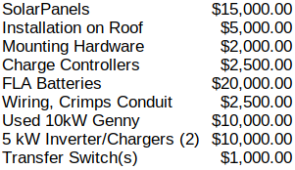Hedges
I See Electromagnetic Fields!
- Joined
- Mar 28, 2020
- Messages
- 20,670
One of those Honda models is shown as 1kW, pretty ideal for the application.
I looked up natural gas/propane CHP (high temperature reformer) and while the concept seems great, actual efficiency numbers for an available product seemed no higher than ICE.
Wood-fired CHP (e.g. Sterling generator) could also be interesting.
Seen a price for the Honda?
It is sine wave inverter output. Have to be careful what inverter system you feed this into - only 8A at 120V available, so want something like Sunny Island that will pick up all excess load when using this generator as AC source. Probably easier to feed it through a battery charger, DC coupled.
I looked up natural gas/propane CHP (high temperature reformer) and while the concept seems great, actual efficiency numbers for an available product seemed no higher than ICE.
Wood-fired CHP (e.g. Sterling generator) could also be interesting.
Seen a price for the Honda?
It is sine wave inverter output. Have to be careful what inverter system you feed this into - only 8A at 120V available, so want something like Sunny Island that will pick up all excess load when using this generator as AC source. Probably easier to feed it through a battery charger, DC coupled.



